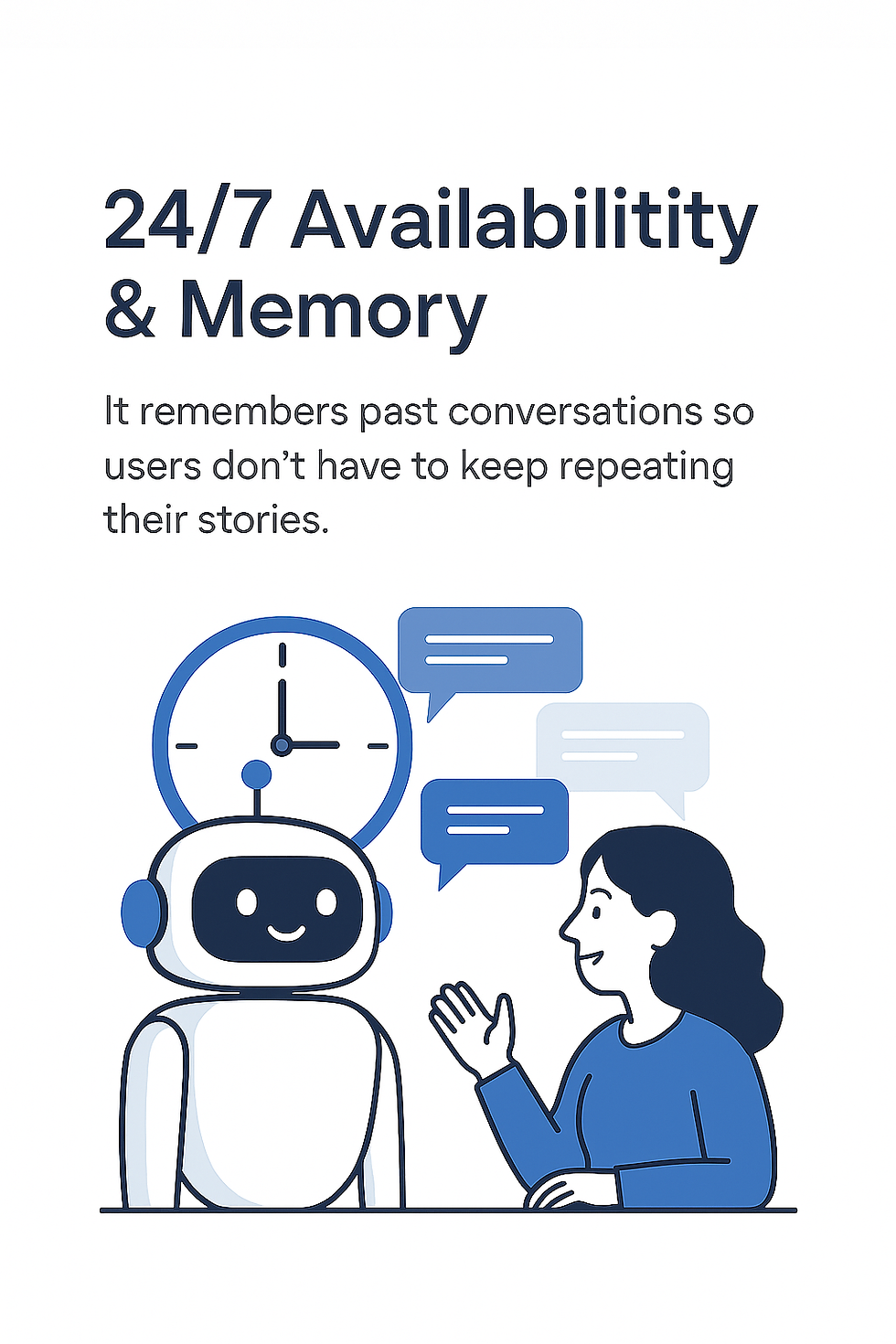What Hapi Delivers
- Yasaman Yazdandoust
- Jul 30
- 4 min read
Friendly Check‑Ins
Hapi checks in regularly, learns from every interaction, and gets smarter over time, making each experience more personal and helpful.

How Check‑Ins Currently Happen in the Justice and Reentry Field
In‑person or live contact with officers (office meetings, home visits, phone or video calls) is standard practice in community supervision policies 1.
Telephone/IVR “call-in” systems let people answer scripted questions and confirm location without speaking to an officer 2.
Kiosk reporting in probation offices or community sites allows low-risk clients to check in by scanning an ID and answering prompts 2,3.
SMS/text reminders and two-way messaging are used to cut missed court dates and improve compliance 4,5.
Supervision apps (e.g., BI SmartLINK) offer calendars, resource links, and secure messaging on a client’s phone 6,7.
Peer-led or program-based digital tools (mobile/web apps) support check-ins (health, housing, goals) alongside resource linkage 8.
Why check‑ins matter
Court and supervision reminders cut failures to appear and related warrants/incarceration by 19–34%, and about 20% in a large randomized study 4.
Overdose risk spikes in the first two weeks after release; timely outreach can surface red flags (relapse, lost meds, housing loss) before they become emergencies 9-11.
Automated kiosk/IVR reporting handled low‑risk clients efficiently and freeing officers to focus on higher‑need cases 12,13.
Smaller caseloads and more purposeful contacts have been linked to lower recidivism; officer support itself functions as a form of social support 14-16.
US States that retooled supervision and communication practices saw double‑digit drops in violation-related prison admissions17.
When people feel heard and treated fairly (procedural justice), compliance and engagement rise, check‑ins are a primary venue to demonstrate that fairness 18,19.

Automated vs. Manual Check‑Ins: Rethinking Everyday Care
Check-ins might seem simple, “How are you doing? What do you need?”, but for people navigating reentry, they can be lifelines. A quick touchpoint can stabilize a spiraling day or flag a brewing crisis. For staff, well-designed systems reclaim time, reduce emotional strain, and provide actionable data.
Inside facilities, people often stay silent about issues like bullying, medical emergencies, or unsafe conditions because speaking up can make things worse. Reporting a problem may lead to being searched, punished, or labeled. This fear of retaliation means many stay quiet to protect themselves, even when someone is in serious danger. Thoughtful, anonymous check-ins and other forms of communication can help surface these hidden risks before they escalate. Automation routes common complaints to the right teams, while human follow-up confirms people were heard. Aggregated data shows where services are missing or policies are not working.
Manual Check‑Ins
Phone calls, in-person meetings, or peer support remain the most nuanced forms of check-in. Humans hear tone, notice inconsistencies, and offer empathy. Familiarity, “How did the court go yesterday?” builds trust, and people are more likely to disclose sensitive topics like suicidal thoughts or interpersonal conflicts.
But manual check-ins are resource-heavy. Each call or visit takes time, and as caseloads grow, routine contact often slips. Staff absorb emotional strain, and documentation is often rushed or inconsistent. Coverage is limited to office hours, leaving gaps overnight or on weekends.
Automated Check‑Ins
Automated tools, SMS bots, apps, IVR, and kiosks can ask frequent, branching questions, flag concerns, and trigger timely follow-up. When done right, they build trust through consistency, responsiveness, and clear action.
They:
Run routine check-ins (“Did you attend your program today?”) in the background, surfacing red flags.
Filter out low-risk updates so staff can focus where they’re most needed.
Offer privacy, and some users disclose sensitive issues more easily to a nonjudgmental interface.
Create clean, structured data that shows trends and systemic gaps.
Capture issues 24/7, even if a human responds later.
However, poor design erodes trust. Cold language, unclear privacy terms, and inaccessible tech discourage use. Trauma histories, language diversity, and low digital literacy require thoughtful design: plain language, multiple language options, and trauma-informed phrasing. Many users rely on basic phones or shared devices.

What It Does for Staff
Cuts the repetitive “Are you still okay? Did you get there?” tasks.
Prioritizes who needs a call today, based on actual risk or need signals.
Gives structured, searchable records instead of scattered notes.
Reduces moral distress, staff know someone (even a bot) checked in at 2 a.m., and they’ll get the alert at 8 a.m. with context.
What Hapi adds
Proactive, friendly messages: Hapi doesn’t just wait for a report; it checks in regularly, asks how things went, and adapts the next nudge. (Builds on evidence that automated reminders cut failures to appear and sanctions.)
Human handoff when needed: Scripted escalation routes urgent signals (“I’m in crisis”) straight to a person, maintaining the supportive, relational layer officers provide.
Caseload relief with safety intact: With Canadian parole officers already stretched thin, and automation shown to handle up to 50% of routine contacts, Hapi meaningfully reduces workload while providing safer, round-the-clock support.
References:
https://play.google.com/store/apps/details/BI_SmartLINK?hl=en_IE&id=com.biinc.mobile.client&
https://pmc.ncbi.nlm.nih.gov/articles/PMC9097827/pdf/nihms-1785026.pdf
https://www.sciencedirect.com/science/article/abs/pii/S0376871619304843
https://www.cmajopen.ca/content/9/3/E907?utm_source=chatgpt.com
https://pmc.ncbi.nlm.nih.gov/articles/PMC8902315/?utm_source=chatgpt.com
https://nij.ojp.gov/topics/articles/automated-kiosks-can-help-community-supervision-agencies-manage-high-caseloads-low?
https://www.tandfonline.com/doi/full/10.1080/0735648X.2025.2532143?src=exp-la&
https://www.sciencedirect.com/science/article/abs/pii/S0047235224000369
https://projects.csgjusticecenter.org/supervision-violations-impact-on-incarceration/key-findings/
https://www.theguardian.com/us-news/2015/jun/23/procedural-justice-transform-us-criminal-courts?
https://bpspsychub.onlinelibrary.wiley.com/doi/10.1111/lcrp.12264?af=R&
Picture




Comments